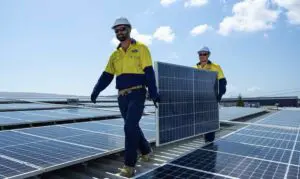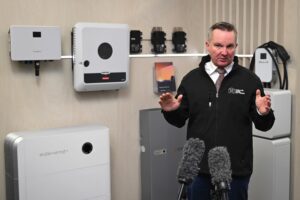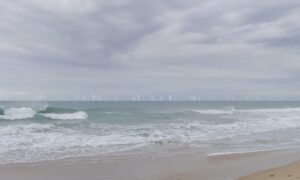The number of battery storage and hydrogen electrolyser projects in Australia soared in 2020, with the capacity pipeline now rivalling that of solar PV and wind energy as developers bet on a rapid transition to a renewables-dominated grid.
New data released by the energy consultants Rystad Energy shows that 19.2GW of battery storage and hydrogen electrolysers (which can also offer storage capabilities) were added to the project pipeline in Australia last year.
(The gigawatt hour number indicating the length is not included as most projects have not fully defined their market opportunity).
This number beats utility scale solar, which added 17.5GW of new projects, and came in just behind wind energy (21GW). In total, there is a pipeline of 225GW or renewable and storage projects jockeying for a position on the grid, although it is clear that not all will get over the line.
This map above shows the number of projects proposals made in November and December alone, with 50new assets owned by 37 companies added to the pipeline, including 1.73GW of wind, 1.45GW of lithium ion batteries, 1.33GW of hydrogen electrolysers, 960MW of solar PV and 400MW of pumped hydro.
The leading state was Queensland, which attracted 1.83GW of new capacity proposals in the last two months of the year, with 1.1GW of that coming from onshore wind projects. NSW attracted 1.56GW, dominated by nearly 1GW of battery storage, while Tasmania was third, thanks to 0.95 GW of new hydrogen electrolyser proposals.
Rystad says there were nine new utility-scale lithium-ion battery assets proposed in November and December, with two of them coming from French developer Neoen – the 500MW Great Western Battery in NSW and the 400 MW Thunderbolt battery project associated with a wind and solar hybrid in northern NSW.
Neoen, which already operates the Hornsdale Power Reserve in South Australia and the Bulgana battery in Victoria, and is also building the 300MW/450MWh Victoria big battery near Geelong, now has the biggest pipeline of battery storage projects in the main grid with 17 assets that total 4.1GW.
The big increase in both battery storage and electrolyser proposals is significant, particularly as low wholesale prices cast doubt about the future of many coal fired generators, and as most utilities and institutions expect an even more rapid shift to renewables than had previously been predicted.
The battery storage projects will get a fillip with the introduction of 5-minute trading later this year, and the re-write of market rules that will open up yet more revenue opportunities for the range of services they can provide.
However, electrolysers at scale will take longer to roll out, mainly because the technology is new and the costs have not yet fallen to where the economics are easy.
Still, state governments are aiming high, seeing hydrogen as an opportunity to produce two or up to six times wind and solar needed for local grid demand, while Andrew Forrest has extraordinary plans to deliver up to 1,000GW around the world and 50GW in the Pilbara region of W.A., which is off the main grid.









